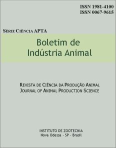Effect of the starter method and the origin of Africanized honey bee (Apis mellifera L., 1758) larvae in mini-hives for royal jelly production
Keywords:
Africanized honey bees, royal jelly, starter, sister larvae, no-sister larvaeAbstract
The present work was carried out with the objective of evaluating the larvae acceptance and the royal jelly production using the starter method for production with Africanized honey bees in comparison with the Doolittle ones. It was, still, evaluated the acceptance and royal jelly production using the larvae originating from of the same beehive (sister larvae) in comparison with the one of another beehive (no-sister larvae). The starter method consists of removing the group of the two superior nuclei (in the last nucleus are the grafted larvae) and to put on a bottom, in front of the inferior nucleus. After 24 hours of the division, returning the group to the original position. During this time the superior nucleus, that were in front of the inferior ones, receive most of the forage bee ones, being without the queen, that is in the inferior nucleus. The crop of the royal jelly was accomplished 72 hours after the larvae transfers, being evaluated, still, the larvae acceptance. By the obtained results it can be concluded that the larvae acceptance in the "starter" method of real jelly production in mini-hive increases in the same proportion of the total production of royal jelly, although the averages in the processes "starter" and Doolittle don€™t present significant differences among themselves. The origin of the grafted larvae (sisters or no-sisters) doesn€™t influence the acceptance or the royal jelly production in beehives of Africanized honey bees.
Downloads
Downloads
Published
Issue
Section
License
Os autores não serão remunerados pela publicação de trabalhos, pois devem abrir mão de seus direitos autorais em favor deste periódico. Por outro lado, os autores ficam autorizados a publicar seus artigos, simultaneamente, em repositórios da instituição de sua origem, desde que citada a fonte da publicação original seja Boletim de Indústria Animal. A revista se reserva o direito de efetuar, nos originais, alterações de ordem normativa, ortográfica e gramatical, com vistas a manter o padrão culto da língua e a credibilidade do veículo. Respeitará, no entanto, o estilo de escrever dos autores. Alterações, correções ou sugestões de ordem conceitual serão encaminhadas aos autores, quando necessário. Nesses casos, os artigos, depois de adequados, deverão ser submetidos a nova apreciação. As opiniões emitidas pelos autores dos artigos são de sua exclusiva responsabilidade. Todo o conteúdo deste periódico, exceto onde está identificado, está licenciado sob a Licença Creative Commons Attribution (CC-BY-NC). A condição BY implica que os licenciados podem copiar, distribuir, exibir e executar a obra e fazer trabalhos derivados com base em que só se dão o autor ou licenciante os créditos na forma especificada por estes. A cláusula NC significa que os licenciados podem copiar, distribuir, exibir e executar a obra e fazer trabalhos derivados com base apenas para fins não comerciais.













